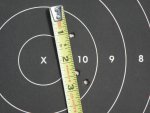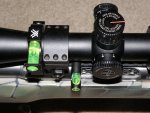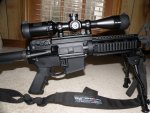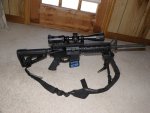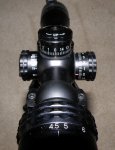Join the Hide community
Get access to live stream, lessons, the post exchange, and chat with other snipers.
Register
Download Gravity Ballistics
Get help to accurately calculate and scope your sniper rifle using real shooting data.

Install the app
How to install the app on iOS
Follow along with the video below to see how to install our site as a web app on your home screen.
Note: This feature may not be available in some browsers.
You are using an out of date browser. It may not display this or other websites correctly.
You should upgrade or use an alternative browser.
You should upgrade or use an alternative browser.
ar15 zero - 100, 200, 300 yard zero? pros/cons?
- Thread starter topslop1
- Start date
What type of optic are you using( scope vs red dot/eotech/acog) and what distances do you plan on shooting?
300 yard zero for a 223?
That's a bit of a zero for a 5.56 bud. For a 308 or bigger I could understand.
Not really, it's what the Marines zero their M4s at with issued optics/irons. Ballistically speaking, using an Acog/eotech, it's a good zero for combat effective shots on a mansize target from 25m out 300m. For precision/windage/elevation scoped weapons, 100m is the preference.
Zero at 100 for a precision weapon using high power variable optics. For BUIS, red dots, ACOG et all use the 50 yard battle zero. The ballistic trajectory lends itself to virtually POA / POI from 0-200 yards that way.


Last edited:
Why not make your zero at 100 yds. and make a drop chart out 400 yds. so you can chart the arc of your bullet as it goes down range. Then have these made for your elevation turret. Then all you have to do is use your laser rangefinder to find the distance to your target. Then turn your elevation turret to the yardage, hold for wind and shoot. I am a big proponent of custom turrets.
I think these cost about $25.00 and stick to your turret that came with your scope.
Custom Turret Systems | Affordable Custom Turret Labels
Here is a custom turret that Vortex made for my that is on my PST 6-24x50mm PST FFP MOA scope. It is dead nuts accurate at every range. This is a 400 yd. target that I turned the turret to 4 for 400 yds and shot without holding for a slight wind.
I think these cost about $25.00 and stick to your turret that came with your scope.
Custom Turret Systems | Affordable Custom Turret Labels
Here is a custom turret that Vortex made for my that is on my PST 6-24x50mm PST FFP MOA scope. It is dead nuts accurate at every range. This is a 400 yd. target that I turned the turret to 4 for 400 yds and shot without holding for a slight wind.
Attachments
Last edited:
Why not make your zero at 100 yds. and make a drop chart out 400 yds. so you can chart the arc of your bullet as it goes down range. Then have these made for your elevation turret. Then all you have to do is use your laser rangefinder to find the distance to your target. Then turn your elevation turret to the yardage, hold for wind and shoot. I am a big proponent of custom turrets.
I think these cost about $20.00 and stick to your turret that came with your scope.
Custom Turret Systems | Affordable Custom Turret Labels
I think the idea is on a high power precision rifle you will be making turret adjustments. It is easier to start at 100 and not ever have to dial down. On an ar15 you don't necassarily have high power optics. Sometimes just a dot. A. 200 yard zero gives you the ease of point and shoot without making adjusments and you will be minute of man.
bigbear_98 I realize what you are telling us. I would think that you would want a scope on a precision rifle. I just suggested this incase anyone will be using a scope. I have settled on a Bushnell AR/223 4.5-18x40mm scope. It is really great for when you want to target shoot or want to shoot at prairie dogs at long range. You can easily zero your turrets after sighting it in.
Best price I have found ($174.99 free shipping). Most sell it for $249.
http://www.sportsmansoutdoorsuperstore.com/products2.cfm/ID/124382/c/bushnell-ar-optics
Best price I have found ($174.99 free shipping). Most sell it for $249.
http://www.sportsmansoutdoorsuperstore.com/products2.cfm/ID/124382/c/bushnell-ar-optics
Attachments
Last edited:
Whats the purpose of your sights? Are they BUIS or Precision?
I have KAC 200-600 BUIS on 16 inch .223 carbine and I wish the drum had gone down to 100. They zero at 300 which is fine but because I want to use my BUIS beyond the reason for their being there I find myself dicking with them. They are backups afterall not supposed to be the main sight system although those KACs do work pretty good.
I set up per instructions to zero at 25m on the Z line (300 yards) but wasnt happy with my steel torso hits at 200 (my most likely distance/reason for their use). I adjusted my front sight for good zero at 200. Now at 100 I have to raise my front sight post to keep a sub six hold on an SR1 target. Id rather see the drum registered 100-500 for my .223 but .308 guys probably think things just fine as they are.
My problem - I shouldnt be expecting back ups to be precision sights. Still waiting on my scope and Ive been told maybe light in the tunnel this month. With the scope on Ill probably go back to a 300 zero and be happy if they hold steel from point blank to 300.
I have KAC 200-600 BUIS on 16 inch .223 carbine and I wish the drum had gone down to 100. They zero at 300 which is fine but because I want to use my BUIS beyond the reason for their being there I find myself dicking with them. They are backups afterall not supposed to be the main sight system although those KACs do work pretty good.
I set up per instructions to zero at 25m on the Z line (300 yards) but wasnt happy with my steel torso hits at 200 (my most likely distance/reason for their use). I adjusted my front sight for good zero at 200. Now at 100 I have to raise my front sight post to keep a sub six hold on an SR1 target. Id rather see the drum registered 100-500 for my .223 but .308 guys probably think things just fine as they are.
My problem - I shouldnt be expecting back ups to be precision sights. Still waiting on my scope and Ive been told maybe light in the tunnel this month. With the scope on Ill probably go back to a 300 zero and be happy if they hold steel from point blank to 300.
Where do you work that accepts 'low' and 'high' and '+ -' as acceptable?I run a 200 yard zero for work.
25- low
50- dead on
100- high
150- high
200- dead on
250+- hold over
I run a 200m zero on my work gun with both an ACOG and the Eotech. Most people have access to and can get a 200m zero and confirm it, 300m can be a bit harder for some. Personally speaking, I find the 200m to be the best for POA/POI shooting for most of the shooting I do with my work gun(M4) as it requires no thought on my part about drops, hold overs, BDCs, etc, just point and shoot. I also have no qualms with a 300m zero, as it has its merits too.


MHIA: Military has its advantages.
LE needs to know exactly where the bullets will land. They don't always know, but they should know.
If you shoot precision rifle in any filed you need to know where your bullets will hit. Whether is USMC-LAPD-AS ARMY or Salvation ARMY.
Even if shooting a M4, I want to know where I'm going to hit.
If the BDC function of the BDC detachable carry handle sight is desired then a 300 meter zero is what must be initially established . Sighting in can be done at 25 meters. This produces a trajectory where line of sight and bullet path will intersect at 300 meters when the BDC is mounted on an M4. When the BDC is mounted on an M16A4, after bottoming out the BDC, it should be taken up 2 clicks to the Z mark when sighting in at 25 meters, since leaving the BDC bottomed out on the A4 would require sighting in at 32 meters for a 300 meter zero. After sighting in the A4 at 25 meters the BDC should then be turned 2 clicks down to actually produce a 300 meter zero. Now, for the most part, this 300 meter zero will allow for hits on the E type target all the way out to about 400 meters when using a center of mass hold and allowing for the full 20 inches of target below center of mass. Out to 350 meters, bullet strikes will be no more than 10 inches high or low using the center of mass hold. This BSZ concept is versatile on unknown distance targets out to the point where the BDC function would be utilized on KD targets.
For precision, either a hold or sight adjustment to actual distance would of course yield a better result if the shooter could muster the knowledge, skill, and resources to understand distance to target, angle to target, wind and weather conditions, and lead for target movement in a timely manner. Thing is "precision" may require time and thus the iron sight in such constraint may not be as precise as alternative sighting devices, such as the ACOG.
Overall, an optic, like the TA-31F ACOG, zeroed at 100 meters seems to me like the most appropriate sighting solution for the M4 for a multitude of reasons, but primarily for the reticle's range estimation and BDC function, which can help the shooter understand both distance to target and holdover in a heart beat. Still, because it is not parallax free, getting as good a hit as might be possible with a scope having a parallax adjustment feature, keeps the ACOG from absolute performance.
For precision, either a hold or sight adjustment to actual distance would of course yield a better result if the shooter could muster the knowledge, skill, and resources to understand distance to target, angle to target, wind and weather conditions, and lead for target movement in a timely manner. Thing is "precision" may require time and thus the iron sight in such constraint may not be as precise as alternative sighting devices, such as the ACOG.
Overall, an optic, like the TA-31F ACOG, zeroed at 100 meters seems to me like the most appropriate sighting solution for the M4 for a multitude of reasons, but primarily for the reticle's range estimation and BDC function, which can help the shooter understand both distance to target and holdover in a heart beat. Still, because it is not parallax free, getting as good a hit as might be possible with a scope having a parallax adjustment feature, keeps the ACOG from absolute performance.
Last edited:
We set our patrol rifles for the 100 yard zero. Urban environment, engagement distances do not stretch out like military applications do.
Low and high at different distances is a reality with both my Acog and AimPoint equipped rifles. Training makes you be able to put the round where it needs to be.
Low and high at different distances is a reality with both my Acog and AimPoint equipped rifles. Training makes you be able to put the round where it needs to be.
If the BDC function of the BDC detachable carry handle sight is desired then a 300 meter zero is what must be initially established . Sighting in can be done at 25 meters. This produces a trajectory where line of sight and bullet path will intersect at 300 meters when the BDC is mounted on an M4. When the BDC is mounted on an M16A4, after bottoming out the BDC, it should be taken up 2 clicks to the Z mark when sighting in at 25 meters, since leaving the BDC bottomed out on the A4 would require sighting in at 32 meters for a 300 meter zero. After sighting in the A4 at 25 meters the BDC should then be turned 2 clicks down to actually produce a 300 meter zero. Now, for the most part, this 300 meter zero will allow for hits on the E type target all the way out to about 400 meters when using a center of mass hold and allowing for the full 20 inches of target below center of mass. Out to 350 meters, bullet strikes will be no more than 10 inches high or low using the center of mass hold. This BSZ concept is versatile on unknown distance targets out to the point where the BDC function would be utilized on KD targets.
For precision, either a hold or sight adjustment to actual distance would of course yield a better result if the shooter could muster the knowledge, skill, and resources to understand distance to target, angle to target, wind and weather conditions, and lead for target movement in a timely manner. Thing is "precision" may require time and thus the iron sight in such constraint may not be as precise as alternative sighting devices, such as the ACOG.
Overall, an optic, like the TA-31F ACOG, zeroed at 100 meters seems to me like the most appropriate sighting solution for the M4 for a multitude of reasons, but primarily for the reticle's range estimation and BDC function, which can help the shooter understand both distance to target and holdover in a heart beat. Still, because it is not parallax free, getting as good a hit as might be possible with a scope having a parallax adjustment feature, keeps the ACOG from absolute performance.
I agree with your first paragraph. I disagree with your second paragraph about the ACOG. The mfgr suggests a 100m zero and its what was/is taught in some conventional units still, unfortunately. Using the BDC proves too time consuming and difficult to use under stress for most shooters on a two way range. Hence the adoption by some units of a 200m zero on ACOGs be it the older Chevron or the newer cross hair models. The BDC xmas tree is simply used for verifying range when time permits but thats it. For all shooting out to 300m, the chevron/crosshair is what is placed center mass on the human/e-type tgt with the knowledge that a 300m shot will likely be in the pelvic region, which is just as desirable for combat effective shooting purposes. I am not a fan of the ACOG but I use it because it's issued to me and what I often have to teach to others as they use it and I need to be familiar with it. I personally prefer an Eotech with a magnifier behind it as I like the versatility and greater eye relief if provides. I use a 200m zero with both and am quiet happy with the results.
This is a question I've been pondring for a while and I've played around with the 50, 100, & 200yd zeroes for several of my 16" 5.56s.
So far the most informative explanantion of the various debated zeroes with the 5.56mm platform was, in my opinion, given by Travis Haley in his (Panteo-produced) Adaptive Carbine vid.
Shooting out to 500yds using 5 different humanoid-shaped targets, Haley establishes 5 different zeros of 25, 50, 100, 200 & 300.
Haley then explains that (1) on any given target the zero was established using a red-dot sight held COM; (2) for each of the 5 zeroes, a "combat effective zone" (CEZ) is defined based on the measured spread of incapacitating hits each target receives out to 500yds; and (3) that holdovers (h/o) outside the CEZ on each target will differ both in number and POA needed to make the hit, again out to 500yds.
Of the 5 CEZs derived from shooting these zeroes, the most "efficient" was the 36yd/300yd zero (the Marine Corp Z), which Haley defines as the smallest measured cluster of incapacitating hits made with a given zero (provided the shooter does his job). The 36/300yd Z had a 5" CEZ out to 300yds, meaning this target received 5 incapacitating hits to the vital organs within a 5" area (COM) with no holdover. This expanded, again with no h/o, to a 14" CEZ when the 400yd hit was included. On the 36/300yd target, the 400yd shot hit the lower stomach/abdomin area. For this zero, the only h/o to learn/memorize was @ 500yds which would be at the knees, so Haley said to hold on the head.
All the zeros on the other targets displayed larger CEZs and had more h/os to learn/memorize. Not gospel, just something to think about.
Panteao Make Ready with Travis Haley: Adaptive Carbine DVD - YouTube
As indicated, I'd been thinking for a while about which zero would make a 16" 5.56mm carbine effective as a fighting rifle as far out as practical without worrying about the zero issue, once you got it set. So I found the Haley/Panteo video very informative on the subject. I was also relieved that it did not appear necessary for the shooter to be wearing Crye multicam combat pants (ala Brad Pitt in WWZ) in order to get effective hits with any of these zeroes.

So far the most informative explanantion of the various debated zeroes with the 5.56mm platform was, in my opinion, given by Travis Haley in his (Panteo-produced) Adaptive Carbine vid.
Shooting out to 500yds using 5 different humanoid-shaped targets, Haley establishes 5 different zeros of 25, 50, 100, 200 & 300.
Haley then explains that (1) on any given target the zero was established using a red-dot sight held COM; (2) for each of the 5 zeroes, a "combat effective zone" (CEZ) is defined based on the measured spread of incapacitating hits each target receives out to 500yds; and (3) that holdovers (h/o) outside the CEZ on each target will differ both in number and POA needed to make the hit, again out to 500yds.
Of the 5 CEZs derived from shooting these zeroes, the most "efficient" was the 36yd/300yd zero (the Marine Corp Z), which Haley defines as the smallest measured cluster of incapacitating hits made with a given zero (provided the shooter does his job). The 36/300yd Z had a 5" CEZ out to 300yds, meaning this target received 5 incapacitating hits to the vital organs within a 5" area (COM) with no holdover. This expanded, again with no h/o, to a 14" CEZ when the 400yd hit was included. On the 36/300yd target, the 400yd shot hit the lower stomach/abdomin area. For this zero, the only h/o to learn/memorize was @ 500yds which would be at the knees, so Haley said to hold on the head.
All the zeros on the other targets displayed larger CEZs and had more h/os to learn/memorize. Not gospel, just something to think about.
Panteao Make Ready with Travis Haley: Adaptive Carbine DVD - YouTube
As indicated, I'd been thinking for a while about which zero would make a 16" 5.56mm carbine effective as a fighting rifle as far out as practical without worrying about the zero issue, once you got it set. So I found the Haley/Panteo video very informative on the subject. I was also relieved that it did not appear necessary for the shooter to be wearing Crye multicam combat pants (ala Brad Pitt in WWZ) in order to get effective hits with any of these zeroes.
Last edited:
This is a question I've been pondring for a while and I've played around with the 50, 100, & 200yd zeroes for several of my 16" 5.56s.
So far the most informative explanantion of the various debated zeroes with the 5.56mm platform was, in my opinion, given by Travis Haley in his (Panteo-produced) Adaptive Carbine vid.
Shooting out to 500yds using 5 different humanoid-shaped targets, Haley establishes 5 different zeros of 25, 50, 100, 200 & 300.
Haley then explains that (1) on any given target the zero was established using a red-dot sight held COM; (2) for each of the 5 zeroes, a "combat effective zone" (CEZ) is defined based on the measured spread of incapacitating hits each target receives out to 500yds; and (3) that holdovers (h/o) outside the CEZ on each target will differ both in number and POA needed to make the hit, again out to 500yds.
Of the 5 CEZs derived from shooting these zeroes, the most "efficient" was the 36yd/300yd zero (the Marine Corp Z), which Haley defines as the smallest measured cluster of incapacitating hits made with a given zero (provided the shooter does his job). The 36/300yd Z had a 5" CEZ out to 300yds, meaning this target received 5 incapacitating hits to the vital organs within a 5" area (COM) with no holdover. This expanded, again with no h/o, to a 14" CEZ when the 400yd hit was included. On the 36/300yd target, the 400yd shot hit the lower stomach/abdomin area. For this zero, the only h/o to learn/memorize was @ 500yds which would be at the knees, so Haley said to hold on the head.
All the zeros on the other targets displayed larger CEZs and had more h/os to learn/memorize. Not gospel, just something to think about.
As indicated, I'd been thinking for a while about which zero would make a 16" 5.56mm carbine effective as a fighting rifle as far out as practical without worrying about the zero issue, once you got it set. So I found the Haley/Panteo video very informative on the subject. I was also relieved that it did not appear necessary for the shooter to be wearing Crye multicam combat pants (ala Brad Pitt in WWZ) in order to get effective hits with any of these zeroes.

The picture I posted above in post #13 is what Haley explains in his video, which isn't something he discovered by any means. And of course, he thinks the 300m is the best which is no surprise since he is a Marine and thats what they zero at religiously. It's not a bad distance to zero at by any means and I've said as much in this thread. What is left out is that just because you zero at 36m doesn't mean you're good to 300m. You have to verify your groups at that distance. We all know what constitutes grouping and to shoot that many rounds at 300m is beyond what most recreational shooters want to shoot to confirm their zero at 300, not to mention you also have other environmental conditions starting to work into the scheme of things at that distance. If you're not concerned with ammo and have the range to shoot 300m then yes, its a good alternative to a 200m zero IMO. Conversely, it's far easier and takes less rounds to shoot a 200m zero by starting on a 25m tgt to make sure your optic is on paper, then shoot and confirm a 100m zero and then adjust to a 200m tgt and adjust and confirm the 200m zero. It can be done with 2 magazines or less of rounds. Now I know some will say they can do it with the 50/200m zero just by zeroing at 50m. My experience with people who claim they have a 50m zero is that their 200m zero and groups look like shotgun blasts, which is why I am a firm believer in confirming at that range, just like we shoot and confirm our dope in precision shooting at each range distance.
Last edited:
Agree w/ you somewhat, but ...
Haley doesn't leave that out. He expressly cautions that the 36yd/300yd Z has to be verified with your carbine and your ammo @ 300yds, and more than once.
By the way, as far as the various Zs go, he likes the 50/200, and from the location of the hits on the targets it's pretty clear that the CEZ of the 50yd Z is almost identical to the CEZ of the 200yd Z.
The Zs on my 5.56s were established first @ 50yds, then verified as hitting @ 200yds, but I found variations even among 55gn FMJ 5.56mm ammo that was supposedly 193XM spec (some hitting higher suggesting the 225 range). So, absolutely yes, you need to verify whether you're hitting the *theoretical* CEZ for that Z @ the longer distance. And all of this changes if you're shooting 62gn, 75gn or 77gn ammo.
As far as how much ammo needs to be expended @ the range to decide which Z works for you, well that's a factor I don't care about. I'm willing to fund the task for the Z I need to make my carbine more efficient as a fighting tool. At the end of the day how much is your life worth?
I found Haley's vid helpful on this issue, ... that's the only point I was making for for the OP.

What is left out is that just because you zero at 36m doesn't mean you're good to 300m.
Haley doesn't leave that out. He expressly cautions that the 36yd/300yd Z has to be verified with your carbine and your ammo @ 300yds, and more than once.
By the way, as far as the various Zs go, he likes the 50/200, and from the location of the hits on the targets it's pretty clear that the CEZ of the 50yd Z is almost identical to the CEZ of the 200yd Z.
The Zs on my 5.56s were established first @ 50yds, then verified as hitting @ 200yds, but I found variations even among 55gn FMJ 5.56mm ammo that was supposedly 193XM spec (some hitting higher suggesting the 225 range). So, absolutely yes, you need to verify whether you're hitting the *theoretical* CEZ for that Z @ the longer distance. And all of this changes if you're shooting 62gn, 75gn or 77gn ammo.
As far as how much ammo needs to be expended @ the range to decide which Z works for you, well that's a factor I don't care about. I'm willing to fund the task for the Z I need to make my carbine more efficient as a fighting tool. At the end of the day how much is your life worth?
I found Haley's vid helpful on this issue, ... that's the only point I was making for for the OP.
Last edited:
Similar threads
- Replies
- 96
- Views
- 3K
- Replies
- 16
- Views
- 3K
- Replies
- 42
- Views
- 2K
- Replies
- 22
- Views
- 2K
- Replies
- 167
- Views
- 7K
